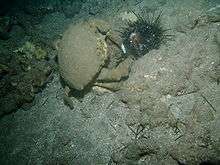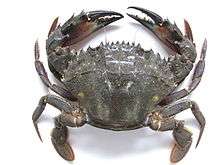Dromiacea
Dromiacea is a group of crabs, ranked as a section. It contains 240 extant and nearly 300 extinct species.[1] Where they are considered to form a monophyletic group, Dromiacea and two other groups of crabs, namely the Raninoida and Cyclodorippoidea, may be collected together into the Podotremata, each at the rank of subsection; morphological and molecular evidence argue against such a grouping.[1]
| Dromiacea | |
|---|---|
 | |
| Dromia dormia (Dromioidea: Dromiidae) feeding on a sea urchin | |
| Scientific classification | |
| Kingdom: | Animalia |
| Phylum: | Arthropoda |
| Subphylum: | Crustacea |
| Class: | Malacostraca |
| Order: | Decapoda |
| Infraorder: | Brachyura |
| Section: | Dromiacea De Haan, 1833 |
| Superfamilies | |
The larvae of Dromiacea resemble those of the Anomura more closely than those of other crabs. This may simply reflect their basal position in the crab phylogeny.
The fossil record of Dromiacea reaches back at least as far as the Jurassic,[2] and, if Imocaris is indeed a member, into the Carboniferous.[3]
The superfamily Eocarcinoidea, containing Eocarcinus and Platykotta, was previously considered to be a member of the Dromiacea, but has since been transferred to the Anomura.[4]
References
- Sammy De Grave; N. Dean Pentcheff; Shane T. Ahyong; et al. (2009). "A classification of living and fossil genera of decapod crustaceans" (PDF). Raffles Bulletin of Zoology. Suppl. 21: 1–109. Archived from the original (PDF) on 2011-06-06.
- J. W. Wägele. "On the influence of fishes on the evolution of benthic crustaceans". Journal of Zoological Systematics and Evolutionary Research. 27 (4): 297–309. doi:10.1111/j.1439-0469.1989.tb00352.x.
- Frederick Schram & Royal Mapes (1984). "Imocaris tuberculata, n. gen., n. sp. (Crustacea: Decapoda) from the upper Mississippian Imo Formation, Arkansas". Transactions of the San Diego Society of Natural History. 20 (11): 165–168.
- Jérôme Chablais; Rodney M. Feldmann; Carrie E. Schweitzer (2011). "A new Triassic decapod, Platykotta akaina, from the Arabian shelf of the northern United Arab Emirates: earliest occurrence of the Anomura" (PDF). Paläontologische Zeitschrift. 85: 93–102. doi:10.1007/s12542-010-0080-y.
Category:Taxa named by Wilhem de Haan
